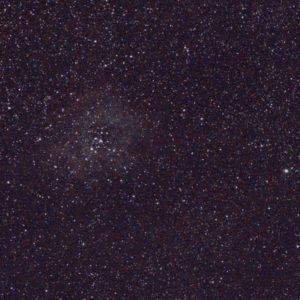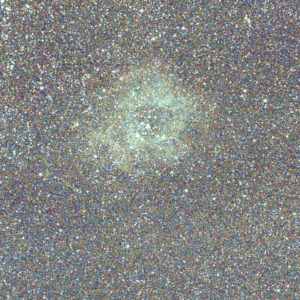
To say I’m frustrated right now would be an understatement. The weather has been so fickle that every time I see even a patch of clear sky I’m scrambling to try to get outside. And yesterday, we had a nice 3 to 4 hour stretch of clear skies. Problem was, I wasn’t home. I was in downtown Krakow, a Bortle 7 zone, looking up at Orion in all its glory. I swear I could almost make out the great hunter sticking his tongue out at me. But I managed to get home just in time to catch the waning minutes of this opportunity to take some quick snaps of the Rosette Nebula.
Why the Rosette Nebula?
There are actually two nebulae that I’m interested in imaging in the near future. Those are the Rosette Nebula and the Witch Head Nebula which sit to the East and West of Orion respectively. What I want to determine is if it’s possible to image these nebulae when just using my camera and a tripod. The Samyang 135mm f/2 seems like the right lens to use to run this experiment. Ideally, I’d like to build a couple of images that show these deep-sky objects at multiple focal lengths and using multiple photographic approaches (ie. tracked vs untracked). I also want to give myself the best chance for success with the untracked approach which is why I chose the Samyang 135mm f/2 lens to kick things off. If my results are poor with this lens, I certainly won’t try with the 50mm f/1.8
Scurrying Around to Setup
Time was not on my side tonight but I needed to head out because I just don’t know if it’ll be another few weeks before I’ll even get a peek at the sky again. So I rounded up all my gear and ran onto the back porch. I set my aperture to f/2.8 and targeted Betelguese as my focus star in the camera viewfinder. Next, I fired up the Canon EOS Utility and APT as described here. Then I took out my trusty Bahtinov mask and went about setting my focus.
Finally Getting to Image
I star hopped to find the little star cluster associated with the Rosette Nebula. A couple of quick test shots told me I’d need to set the ISO to 6400 tonight because I am only exposing for 1 second. The exposure is set about 20% longer than the NPF Full formula indicates. But I think it’ll be OK for this experiment.
I set the program to rip off 50 exposures and then hit start. On a side note, when I’m taking the shorter exposures, I find it best to skip the screen preview in Astro Photography Tool. I also prefer in this case to load the photos to the camera card only. When running a tracked session, the extra 5-10 seconds of data transfer aren’t bothersome. But you don’t want to wait 10 seconds between 1-second exposures.
So everything went well, right? Not even close… By the time I got to the end of the first round of 50 exposures, the clouds started rolling in. I stood by the tripod and kept the Nebula in the center of my frame but I had to wait a good 10 minutes before kicking the next round off. Then more clouds, followed by more waiting, and let’s throw in a battery-low warning for kicks. So all in all, I was only able to take about 200 photos and I had to throw half of them away due to clouds. Bummer.
Processing the Results
As per my usual routine, I stacked my photos in Deep Sky Stacker and then did some light post-processing in Siril before taking that into GIMP for stretching. So the moment of truth was upon me – did I capture any of the Rosette Nebula detail?
Funny enough, the answer is yes and no. I didn’t expect much with only 100 seconds of integration time. Couple that with the fact that I was playing hide and seek with the clouds and the nebula was sitting directly over the heavy light pollution of Krakow. So my expectations were entirely realistic. But the bigger question remains – is it even worth trying to shoot this nebula with only a camera and a tripod. The answer to that is, I’m not sure. I need to get out and do a proper series with this target to be sure. At least I have enough data that tells me it’s worth trying again. What am I talking about?
The Big Reveal

The picture to the right shows the image that I processed. I intentionally over-saturated the picture to try and pick up the faint details in the mid-tones of the image. If you squint really really really hard, you can begin to see some of the color and luminance changes of the Rosette Nebula. Yeah, unimpressive right now, I know. To be honest, I’m not that discouraged given that this is only 100 seconds of integration time. It tells me well enough that it’s worth another go. And I have more evidence to support the attempt.

The picture on the left is of a histogram stretch produced in Siril. Here you can clearly see that the nebulosity is being captured in the images. So, in order to produce a workable image, I’m going to need to improve my signal-to-noise ratio quite a bit more. I think I can do this – even with my current setup. I’ll need to get a little further away from my current location to get away from as much light pollution as possible. And I can open up the aperture another stop which will double the amount of light I’m able to collect.
Lessons for Next Time
I think for my next session with the Rosette Nebula, I’m going to shoot with the Samyang again but at f/2. But only if I can get it to focus at f/2 – it’ll be tight without modification. Next, I’m going to sacrifice a little bit of exposure time and shoot 0.8-second exposures. This is still about 14% higher than the NPF formula indicates, but hopefully, I’ll still be able to keep the stars round at f/2.
I’m also going to set up a vibration pause on the camera to mitigate any mechanical issues. This really shouldn’t be a problem at 135mm, but why even take the chance. I’m going to have to adjust the tripod every 50 or so exposures so it’s not that much of a bother.
Finally, I may try to get away from the city a bit. That will all depend on if I can trust the forecast for any given day. But in general – it’s always cloudy here. Who knows, maybe we’ll get lucky in the coming weeks and I can jot out West a bit so I’m not directly shooting towards Krakow. Anyway, that’s the game plan for right now and I’m looking forward to getting out again soon – hopefully.
